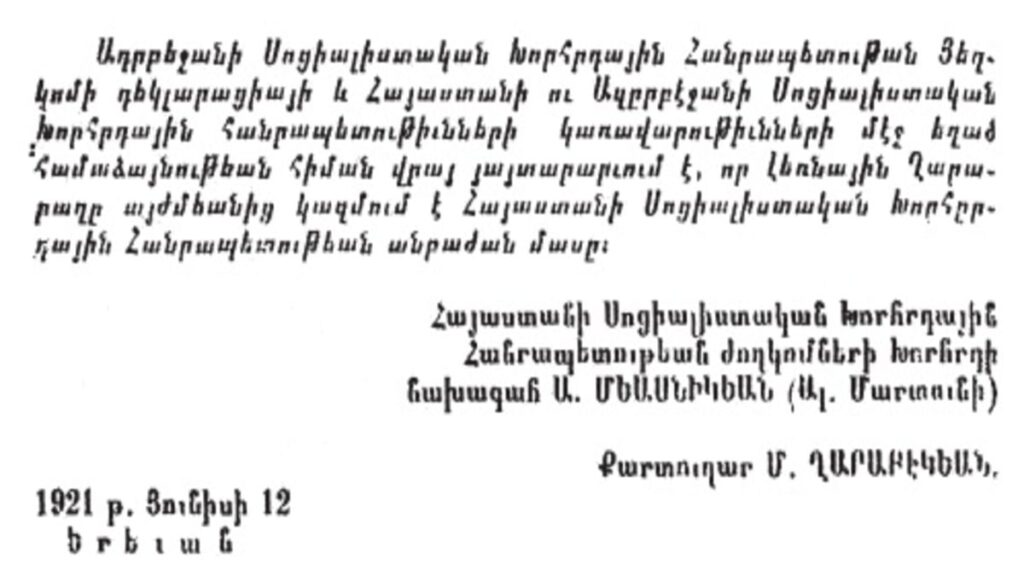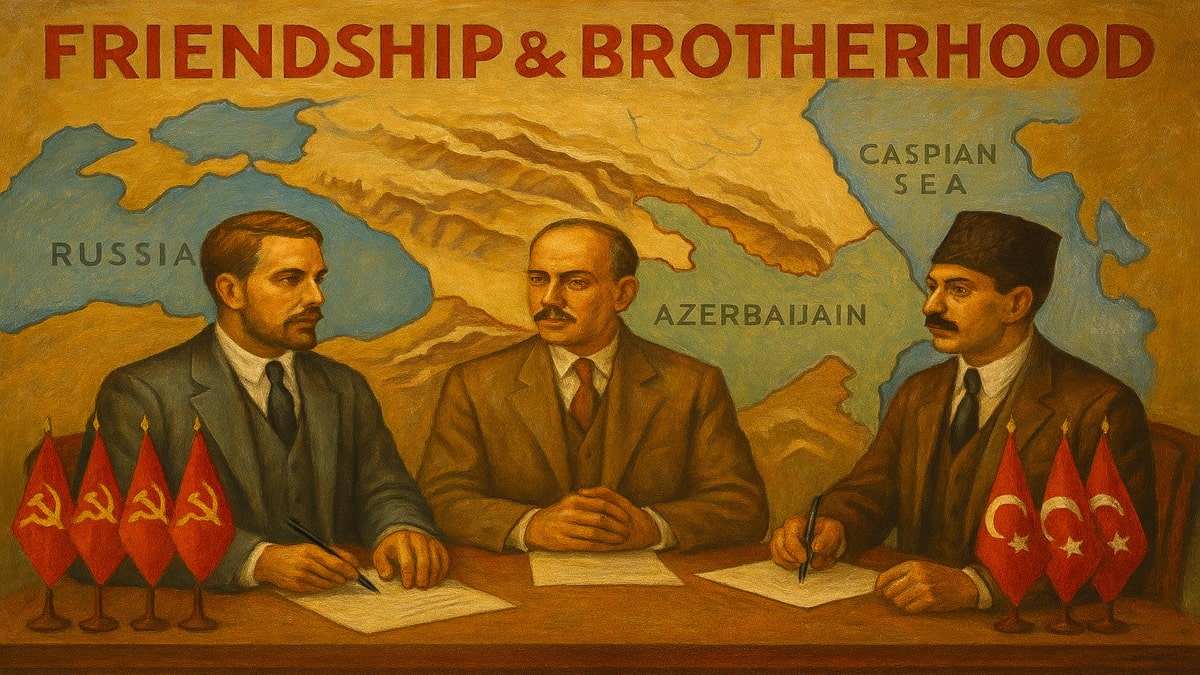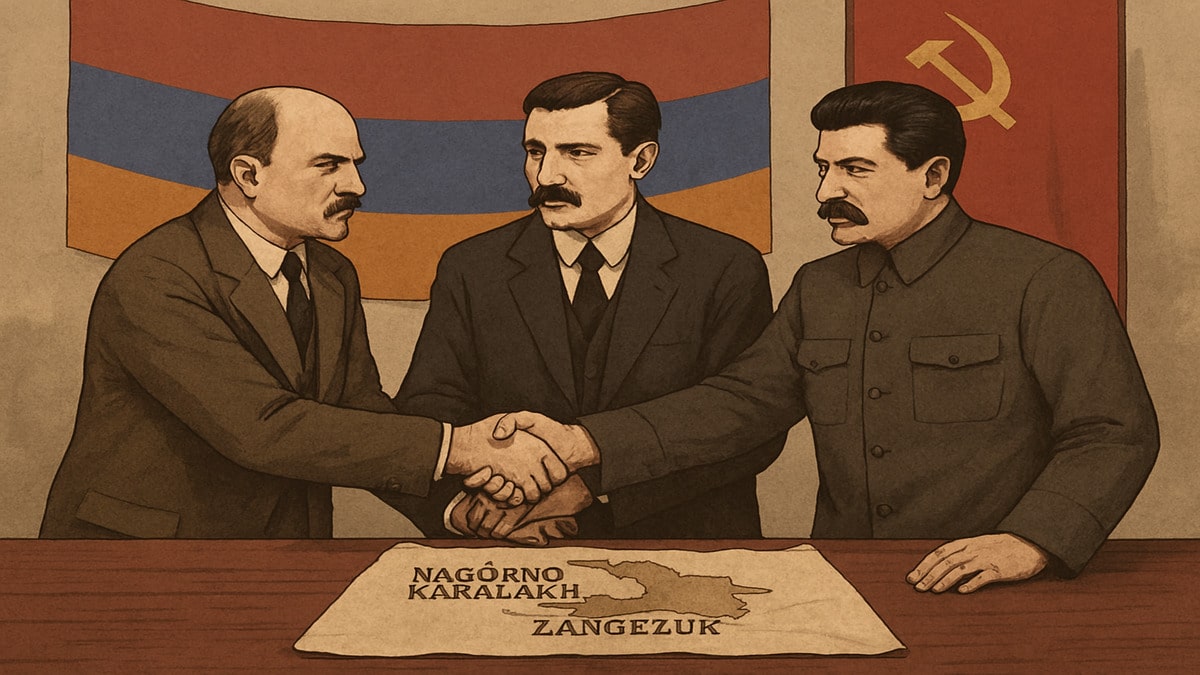
Statement of the Chairman of the Nominal Armenian Delegation at the Moscow Conference and People’s Commissar for Foreign Affairs of Armenia A. Bekzadyan to the People’s Commissar for Foreign Affairs of the RSFSR G. Chicherin, condemning the complete disregard of the sovereign rights and vital interests of Armenia in the Moscow Treaty Moscow, April 15, 1921
Having examined the text of the treaty concluded between the RSFSR and Kemalist Turkey on March 16 of this year, as well as the protocols of the Russo-Turkish Conference sessions of March 10, 12, 14, and 16, the Armenian Delegation finds it necessary to make the following declaration.
First and foremost, one is struck by the ease with which the Russian Delegation made a series of major territorial concessions to the Turks at the expense of Soviet Armenia. Nowhere is there evidence of even the slightest attempt to defend those lands and districts which are of vital importance to the young and small Soviet Republic. Excluded from participation in the sessions of the conference, the representatives of Soviet Armenia were entitled to expect attentive consideration of their needs and interests by the representatives of the RSFSR, and a particular insistence upon the defense of its inalienable rights. Yet the protocols of the Russo-Turkish Conference depict an entirely different reality.
[…]
At the very first meeting of the Armenian Delegation with Comrade Chicherin, the latter promised to keep the delegation informed of all questions concerning Armenia to be discussed at the conference, and to establish a special commission for their elaboration. This promise was not fulfilled, and the Armenian Delegation took no part whatsoever in the proceedings of the conference. Why? As is evident from the protocols (see the protocol of March 12), this exclusion occurred at the demand of the Turkish Delegation. How, then, is one to qualify the pliancy and conduct of the Russian Delegation in this matter?
In the view of the Armenian Delegation, it is most peculiar that the protocols (see March 12) record statements of the Turkish Delegation concerning alleged violence committed by Armenian detachments against 625 Muslims of Transcaucasia (events dating to 1918), while not a word is said of the mass killings and atrocities inflicted upon Turkish and Russian Armenians from 1914 through 1921, as a result of which entire Armenian provinces and districts were reduced to desert, hundreds of thousands of people were turned into homeless refugees, and multitudes perished of hunger and epidemic disease. In the absence of the Armenian Delegation at the conference, this circumstance ought to have been raised before the Turkish Delegation and entered into the record—especially since the now-classic Turkish atrocities against the peaceful laboring population chronologically preceded the Armenian acts and in scale surpassed all human imagination. Regrettably, this was omitted by the Russian Delegation, despite the fact that Comrade Chicherin had been duly informed of all these matters.
The massacres of Armenians by the Turks in 1918 were confirmed by Comrade Chicherin’s note of April 13 of that year, protesting against Turkish atrocities and addressed to the German Government. The massacres of 1920–21, committed by the forces of the very Turkish Government whose representatives at the conference accused Armenians of violence against Muslims, must have been known to the Russian Delegation from the protest of the Alexandropol Revolutionary Committee against the policy of devastation and extermination of Armenians in the districts occupied by the Turks, as well as from the notes of the People’s Commissariat for Foreign Affairs of Soviet Armenia submitted by Comrade Bekzadyan.
[…]
Passing to the question of the violation of its rights, the Armenian Delegation cannot remain silent on the fact that, without its knowledge, participation, or consent, the Russian Delegation ceded a number of Armenian territories to Kemalist Turkey, thereby trampling upon the recognized rights of Soviet Armenia and inflicting a grievous blow upon the living body of the working masses of that country. Indeed, by what reasoning could the Russian Delegation so lightly surrender to Angora a series of districts and regions populated by Armenians? Was it on the assumption that the sovereignty of the newly formed republics is an extremely elastic, conditional, and precarious concept? Was it that the interests of revolution in the East demanded such sacrifices at the expense of the workers and peasants of Soviet Armenia? Or was it, perhaps, that in choosing between a large and powerful Turkey and a small and weak Armenia, the latter was sacrificed to the former?
The Armenian Delegation expresses its resolute protest and asserts that in its negotiations with the Turks the Russian Delegation disregarded the principle of national self-determination, so solemnly proclaimed in all acts and notes of the RSFSR of paramount state and international significance. The negotiations of the RSFSR with Angora at the peace conference demonstrate plainly that this principle was not applied in practice when the occasion presented itself, and was needlessly trampled upon and cast aside.
It was incumbent upon the Russian Delegation of the Workers’ and Peasants’ State to defend Soviet Armenia rather than bourgeois-Kemalist Turkey, for the interests of the Soviet country in no case ought to have been sacrificed to the illusory benefits of foreign policy.
[…]
The violation of the sovereign rights of the Soviet Republic of Armenia cannot be justified by reference to the interests of revolution in the East, and therefore any such invocation is not serious. The protocols of the conference could furnish numerous citations (see March 10 and 12) irrefutably proving that the Russian Delegation not only acknowledged the suzerain rights of Georgia and the sovereign rights of Azerbaijan over this or that territory, but even took them under its protection and curbed the excessive appetites of the Kemalists. Why, then, was this not observed in the discussion of questions directly concerning Soviet Armenia? The question of Kars was not raised at the conference at all.
[…]
The new borders established by the conference provide no security. The two major centers left to Armenia—Alexandropol and Erivan—are placed under the immediate threat of hostile Kemalist Turkey. The new wave of emigration from Armenia, numbering 400,000 persons according to Centroevac, is symptomatic in this regard. By the resolution of the Nakhichevan and Sharur-Daralaghez question adopted at the conference, Armenia is deprived of the possibility of normally administering Zangezur, which belongs to her. By the detachment of Sarykamysh, Kars, Kagyzman, and others, Armenia is economically deprived of its most important districts—fuel, fodder, salt, and more. Under such conditions, considering also the absence in Armenia of a social basis for communist work and successful party construction, as well as the sentiments of the peasantry, which has received nothing thus far from Soviet power and is easily made the instrument of adventurers, one may conclude that the very viability of Soviet Armenia is placed in question.
In the deep conviction of the Armenian Delegation, all this was not caused by inevitable objective circumstances, but solely by the absence of a definite, considered policy and directives from the Central Committee of the RCP imparted to the RSFSR Delegation, by the composition of the latter (its unfamiliarity with the situation in Transcaucasia), and by the ease with which it deemed itself entitled to decide questions of life and death for Soviet Armenia.
Chairman of the Delegation and People’s Commissar for Foreign Affairs of the SSR of Armenia A. Bekzadyan
AVPR, f. 04, op. 39, p. 232, d. 53001, ll. 57–62. Original. Autograph. (Highlighted by us – Yu.B.)
From the Minutes of the Plenum of the Central Committee of the Communist Party of Armenia
On the Appointment of A. Ioannisyan as Plenipotentiary of the Armenian SSR in Nagorno-Karabakh May 23, 1921
Heard: …9. The situation in Nagorno-Karabakh. Resolved: 9. To appoint Comrade Akop Ioannisyan as plenipotentiary of the Armenian SSR in Nagorno-Karabakh, and to summon him by telegraph from Baku to Tiflis to receive directives and instructions from Comrade Bekzadyan.
PAAF MML, f.1, op.1, d.39, l.5 verso. Original. Typescript. Published in the collection Nagorno-Karabakh in 1918–1923, Yerevan, 1992, doc. no. 437.
Resolution of the Plenum of the Caucasian Bureau of the Central Committee of the RCP(b)
On the Preparation of Military Suppression of the Anti-Soviet Uprising in Zangezur and Confirmation Thereby of the Belonging of Nagorno-Karabakh to Armenia [Appendix to Protocol No. 6] June 3, 1921
Annotations: “Top Secret,” “Comrade Makharadze.”
- To liquidate Zangezur by the end of June.
- To begin immediately the preparation of military operations.
- Simultaneously with preparations, the Government of Armenia is to send its declaration to Zangezur in response to the statement of representatives of the Zangezur Government.
- Together with the dispatch of the declaration, measures are to be taken for the immediate occupation of Meghri.
- In the declaration of the Armenian Government, it must be stated that Nagorno-Karabakh belongs to Armenia.
- In the interval between the presentation of the declaration and the commencement of military operations, representatives of the Georgian and Azerbaijani Governments are to be sent to Zangezur for mediation.
- To liquidate Kurdistan simultaneously with Zangezur.
Secretary: Figatner Certified: Acting Head of the Administrative Department of the Caucasian Bureau, Ershova Seal of the Caucasian Bureau of the CC RCP(b)
RGASPI, f.64, op.1, d.1, l.77. Certified copy. (Highlighted by us – Yu.B.) Dated by the time of approval.
Telegram of the Acting Head of the Operations Department of the 1st Caucasian Corps, Yakubovich, to the Head of the Operations Directorate of the Separate Caucasian Army, requesting precise boundaries of Georgia with Armenia with reference to the relevant treaty provisions
June 6, 1921
Secret. Operational 6/6.21. Baku.
By order of Comrade Ordzhonikidze, I urgently request, no later than 20:00 on June 7, to communicate the precise boundaries of the Georgian SSR and the Armenian SSR, with reference to the relevant points of treaties and resolutions. In reporting the boundaries of the Armenian SSR, the Nakhichevan Region is to be taken into account as being under the protectorate of the Azerbaijani SSR. HP 783/op.
Acting Head of Operations Department of the 1st Caucasian Corps, Yakubchik.
RGVA, f.25873, op.1, d.990, l.15.
- Georgian SSR. ** Refers to the Nakhichevan Region.
Report of the Chief of Staff of the 1st Caucasian Corps to the People’s Commissariat for Foreign Affairs of the RSFSR
On the Boundaries of the Three Transcaucasian Republics, with Mention of the Resolution of the Azerbaijani Revolutionary Committee on the Transfer of Karabakh and Zangezur to Armenia No. 822/op. Baku, June 9, 1921
By order of Comrade Ordzhonikidze, I report the boundaries of the Georgian, Armenian, and Azerbaijani Soviet Socialist Republics:
Armenia. On the north, the boundary of Armenia begins at Mt. Uch-Topolyar-chta at the junction of the old administrative borders of the Tiflis Governorate, Ardahan and Kars districts, and proceeds eastward along the old administrative border of the Kars district and Alexandropol county with the Tiflis Governorate to Mt. Ayrtapa 7965, thence north along the old administrative border of the Kazakh county with the Tiflis Governorate to Mt. Shishtapa, and then eastward approximately along the line of Armenian villages occupied by Russian-Soviet units as of June 11, 1920—Aksibara, Uzunbala-Tauzkala, Kulali—and thence south along an unnamed river to Mt. Murguz, and further along the old administrative border of the Elizavetpol and Erivan Governorates, then eastward along the same to Mt. Ginal-dag 11057. Beyond this point the boundary of Armenia is not precisely determined, nor is it clarified on the section from St. Shishtapa to Mt. Murguz. The establishment of precise boundaries between the Transcaucasian republics will be decided at a forthcoming conference of these republics in Tiflis.
Karabakh and Zangezur, having a large percentage of Armenian population, by resolution of the Azerbaijani Revolutionary Committee on the liquidation of the Zangezur counterrevolution, are to pass to Armenia. The Nakhichevan Region, however, according to the treaty concluded in Moscow with Turkey, is at present under the protectorate of Azerbaijan.
On the south, the boundary of Armenia, beginning at Mt. Bagarsykh 6594 (78–89 versts northwest of Nakhichevan), proceeds to St. Ararat, thence along the Kokhanovsky Canal to the River Araks, and further along the right bank of the Araks upstream to its confluence with the River Arpachay, where the boundary turns north. On the west, the boundary runs from the mouth upstream along the River Arpachay, i.e., along the old administrative border of the Erivan Governorate with the Kars Region to the village of Bayandur, thence north through the village of Vartanly to Mt. Akhbaba 9973, and further to Mt. Uchpalyar.
Azerbaijan. On the north, the boundary of Azerbaijan <…>. On the west, the boundary between Azerbaijan and Armenia is not precisely determined up to Mt. Shishtapa, whence it proceeds north along the old administrative border of the Kazakh county with the Tiflis Governorate to the railway bridge across the Kura at St. Poili.
Chief of Staff of the 1st Caucasian Corps, V. Voronkov.
CPA IML, f.85, op.16, d.44, l.3. Certified copy. Typescript. Published in the collection Nagorno-Karabakh in 1918–1923, Yerevan, 1992, no. 440. (Highlighted by us – Yu.B.)
- Copy sent to Baku to G.K. Ordzhonikidze.
From the Minutes of the Meeting of the Central Committee of the Communist Party of Armenia
On the Issuance of a Declaration on the Accession of Nagorno-Karabakh to Armenia and the Dispatch of Representatives Headed by A. Mravyan to Karabakh No. 10, June 12, 1921
Present: Myasnikyan, Makintsyan, Mravyan, Lukashin, Karinyan, Azatyan, Avis, and Khachiev.
Heard: …2. On Nagorno-Karabakh. Resolved: 2. To issue a declaration on the accession of Nagorno-Karabakh to Soviet Armenia.
Heard: …5. On the dispatch of a representative to Karabakh. Resolved: 5. To send Comrade Mravyan to Karabakh together with a group of comrades—Pirumov, Akop Ioannisyan, Ter-Simonyan, and others.
PAAF IML, f.1, op.1, d.39, l.10 and verso. Original. Typescript. Published in the journal Vestnik Arkhivov Armenii, 1989, no. 2, p.72.
Official Announcement of the Council of People’s Commissars of the Armenian SSR
On the Belonging of Nagorno-Karabakh to Armenia as Its Inalienable Part, in Accordance with the Declaration of the Azerbaijani Revolutionary Committee and the Intergovernmental Agreement Yerevan, June 12, 1921
On the basis of the declaration of the Revolutionary Committee of the Socialist Soviet Republic of Azerbaijan and the agreement between the governments of the Socialist Soviet Republics of Armenia and Azerbaijan, it is hereby announced that henceforth Nagorno-Karabakh is an inalienable part of the Socialist Soviet Republic of Armenia.
Chairman of the Council of People’s Commissars of the SSR of Armenia A. Myasnikyan (Al. Martuni)
Secretary M. Karabekyan
TsGAORSS Armenia, f.113, op.3, d.56, l.31. PAAF IML, f.1022, op.2, d.197, l.2. Printed copy; newspaper Khorurdain Hayastan, June 19, 1921 (translated from Armenian). Published in Vestnik Arkhivov Armenii, 1989, no.1, doc. no.23, p.126. (Highlighted by us – Yu.B.). 676
Yuri Barsegov “Nagorno-Karabakh in International Law and Global Politics”
Artatsolum
Read Also:
- Ancient and Medieval Sources on Artsakh (Karabakh) as Part of Armenia’s State Territory
- Message from Gandzasar Catholicos Esayi to Peter I August 10, 1716
- Memorandum Issued to Ivan Karapet Along with the Imperial Letter to the Armenian People Regarding Russia’s Readiness to Take the Armenians of Karabakh Under Its Protection June 3, 1723
- Decree of Peter I to the Armenian People Regarding Russia’s Willingness to Offer Protection to the Armenians of Karabakh
- On Armenian Hopes for Russian Assistance
- Report of Minas Vardapet to Peter I
- Contents of the Secret Letters from the Armenian Assembly and the Armenian Army of Karabakh to the Russian Emperor and Chancellor August 1724
- Contents of the Secret Letters from the Armenian Assembly and the Armenian Army of Karabakh to the Russian Emperor and Chancellor August 1724
- State Charter of Peter I On the Acceptance of the Armenian People Under the Protection of the Russian State and Their Resettlement from Karabakh to Newly Acquired Persian Provinces November 10, 1724
- Letters from the Catholicos and the Meliks of Karabakh
- Charter of Catherine I Addressed to the Armenian Assembly
- Message General Mkhitar—to the Russian Government
- The Armenian Assembly’s Request for Military Assistance June 19, 1727
- Result from Russia’s failure to fulfill its promises of assistance to the Armenians March 1736
- On the Issuance of the Decree Appointing Panah Khan
- Letter from General Potemkin to Prince Argutinsky with questions about the liberation of Armenia
- Appeal of Gandzasar Catholicos Hovhannes to Catherine II
- Letter from Melik Apov Iosifov to Provide Assistance to Russian Military Forces for the Liberation of Enslaved Karabakh
- Report of Prince G. Potemkin to Catherine II
- Request of General P. Potemkin to Prince G. Potemkin
- Letter from Archbishop Joseph Argutinsky to General P. Potemkin
- Memorandum to Catherine II on the Project for the Restoration of the Armenian Kingdom
- Decree of Paul I to General Count I. Gudovich
- Letter from Archbishop Joseph Argutinsky
- Report by State Councillor P. Kovalesky
- The Khan’s Vizier, Mirza Jamal Javanshir Karabakhsky
- From the Report of General Marquis Palluci to Alexander I
- The Gulistan Treaty – An Interstate Act of Iran’s Cession of the Karabakh Territory to Russia
- Report of General A. Yermolov to Alexander I Requesting the Waiver of Tax Arrears for the Karabakh Khanate
- LETTER FROM GENERAL A. YERMOLOV TO MEHTI-KULI KHAN
- Directive from General A. Yermolov to General I. Velyaminov
- Letter of Metropolitan Sarkis Hasan-Jalalyan To General A. Yermolov
- Letter from General I. Paskevich
- TREATY CONCLUDED BETWEEN RUSSIA AND PERSIA AT TURKMENCHAY
- Russian Military Historian V. Potto on the Essence of the Treaty of Turkmenchay
- Order of General I. Paskevich to Colonel L. Lazarev
- STATEMENT ON THE DIFFERING ATTITUDES OF ARMENIANS AND TATARS TOWARD THE ANNEXATION OF KARABAKH TO RUSSIA
- REPORT By the Acting Uezd Chief of the Dzhevanshir Uezd, D. Baranovsky
- From the Memoirs of a Member of the Russian National Council in Baku (1918–1919)
- “TREATY OF PEACE AND FRIENDSHIP” Between the Ottoman Empire and the Republic of Armenia
- Letter from A. Mikaelyan, Representative of the Karabakh and Zangezur Fellowship
- Note of Protest from the Ministry of Foreign Affairs of the Republic of Armenia
- Appeal of the Karabakh Armenian National Council To the Commander of Allied Forces in Baku
- LETTER FROM THE CHAIRMAN OF THE KARABAKH ARMENIAN NATIONAL COUNCIL
- Turks in Shushi
- Letter of Welcome from the Karabakh Armenian
- LETTER FROM GENERAL BAGRATUNI
- FROM THE MESSAGE OF THE ARMENIAN TELEGRAPH AGENCY
- REPORT FROM THE DIPLOMATIC REPRESENTATIVE OF ARMENIA IN GEORGIA
- Resolution of the Fifth Congress of Armenians of Karabakh
- Report by Prime Minister Hatisov to the Council of Ministers of Armenia
- FROM THE MEMORANDUM OF THE KARABAKH ARMENIAN NATIONAL COUNCIL
- 🇬🇧 ANNOUNCEMENT OF THE BRITISH MILITARY MISSION IN SHUSHA
- From the Memorandum of the Armenian Representative to the British Military Mission in Shusha
- Report from the Office of the Governor-General of Karabakh
- NOTICE FROM THE REPRESENTATIVE OF THE BRITISH MILITARY MISSION IN SHUSHI
- 🇬🇧 Doubts Expressed by British Delegate Eric Forbes Adam
- LETTER FROM THE ARMENIAN DIPLOMATIC REPRESENTATIVE
- Assessment by the Karabakh Armenian National Council
- “The Caucasian Word” on the Confirmation by a British Command Representative
- Letter from the Acting Governor-General of Karabakh
- OVERVIEW OF THE SITUATION IN THE CAUCASUS
- Proclamation of the Zangezur Armenian National Council
- Telegram from the Prime Minister of Armenia to the British High Commissioner
- MESSAGE TO THE DIPLOMATIC REPRESENTATIVE
- Photographic Evidence of the Annihilation of Shushi’s Thirty-Thousand Strong Armenian Population
- Appeal of the Karabakh Soldiers and Officers of the Armenian Army
- Territorial Dispute Between the Azerbaijan SSR (as part of the RSFSR) and the Republic of Armenia
- Telegram from the Minister of Foreign Affairs of Armenia
- Telegram from G. Ordzhonikidze to V. Lenin, I. Stalin, and G. Chicherin
- LETTER FROM MEMBERS OF THE CAUCASIAN BUREAU OF THE CENTRAL COMMITTEE OF THE RCP(B): A. AVANESOV, R. KATANYAN, AND AYKUNI
- Report of the Karabakh Community Delegation of Tiflis
- From the Report of People’s Commissar for Foreign Affairs of the RSFSR
- Letter from the People’s Commissar for Foreign Affairs of the RSFSR, G. Chicherin, to V. Lenin
- EXCERPT FROM THE MINUTES OF THE MEETING OF THE POLITBURO
- LETTER FROM MEMBERS OF THE CAUCASUS BUREAU OF THE CENTRAL COMMITTEE OF THE RCP(B)
- LETTER FROM MEMBERS OF THE CAUCASUS BUREAU OF THE CENTRAL COMMITTEE OF THE RCP(B) 11TH RED ARMY
- Telegram from the People’s Commissar for Foreign Affairs of the RSFSR, G. Chicherin
- Appeal from the Commander of the Armenian Expeditionary Detachment
- TELEGRAM OF THE PLENIPOTENTIARY REPRESENTATIVE OF THE RSFSRIN ARMENIA B. LEGRAND
- Letter from Armenian Foreign Minister A. Ohandjanian to the Head of the French Military Mission
- Telegram from Member of the Caucasian Bureau of the Central Committee
- Telegram from Member of the Caucasian Bureau of the Central Committee of the RCP(b)
- First Addendum to the Draft Peace Treaty between the RSFSR and the Republic of Armenia
- Telegram via Direct Line from RVS Member of the Caucasian Front V. Trifonov
- THE ATTITUDE OF THE ALLIED HIGH COMMISSIONER IN ARMENIA, COLONEL GASKELL, TOWARDS THE ARBITRARILY ESTABLISHED BORDERS OF THE TRANSCAUCASIAN STATES
- The Question of Armenia’s Borders at the First (Preliminary) Conference of the Allied Powers in London
- 🇺🇸 U.S. SENATE RESOLUTION NO. 359
- LETTER FROM THE HEAD OF THE DELEGATION OF THE REPUBLIC OF ARMENIA REGARDING THE AGGRESSION OF BOLSHEVIK RUSSIA, SOVIET AZERBAIJAN, AND KEMALIST TURKEY
- DISCUSSION ON THE PROTECTION OF ARMENIA FROM AGGRESSION AND THE THREAT OF EXTERMINATION OF THE ARMENIAN PEOPLE
- Telegram from the Council of the League of Nations to the President of the United States
- Telegram from Lloyd George (sent via Curzon)
- SOVIETIZATION OF ARMENIA
- Letter from the People’s Commissar for Foreign Affairs of the RSFSR, G. Chicherin, to V. Lenin on the Danger of Kemalist Realignment with the Entente
- LETTER FROM THE PLENIPOTENTIARY REPRESENTATIVE OF THE AZERBAIJAN SSR TO THE RSFSR


